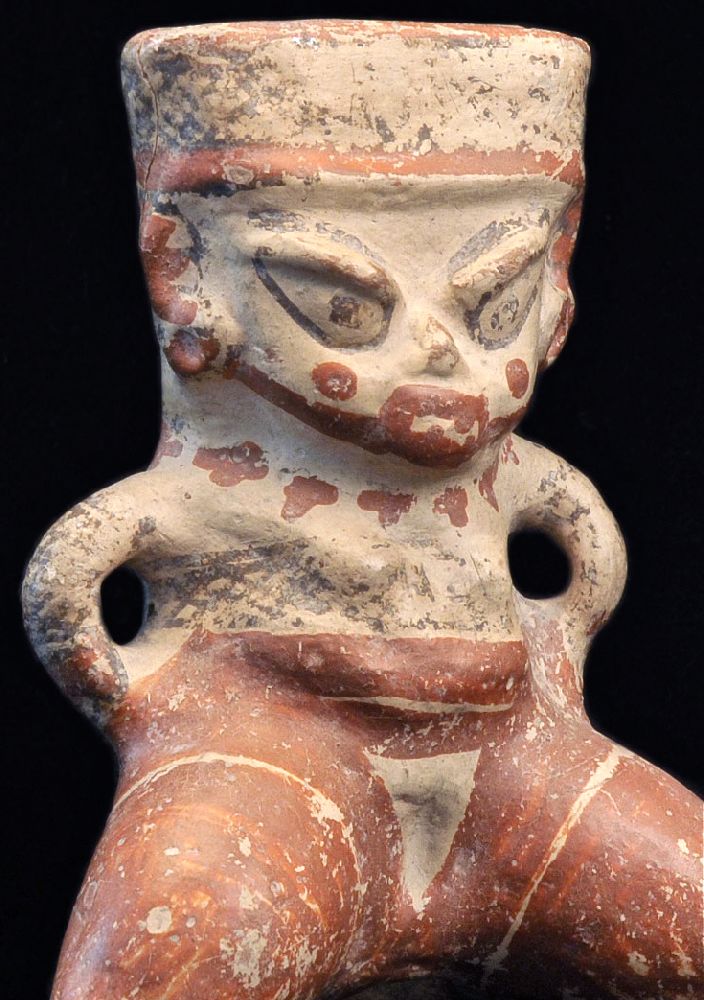

Title: Ancient Nicoya Spread Leg Female Sex Art Figure Clay Ceramic Pottery
Shipping: $29.00
Artist: N/A
Period: Antiquity
History: N/A
Origin: N/A
Condition: Museum Quality
Item Date: Ancient
Item ID: 5947
NICOYA SPREAD LEG FEMALE FIGURE. 18 x 13 cm. Cracks to back. Provenance: An Italian collection collected by the family of the current owner in the 1950's in Buenos Aires. Good and legal provenance provided to buyer. The term Greater Nicoya defines a Pre-Columbian cultural area that comprised the regions of Guanacaste and Nicoya in the northwestern portion of the modern Latin American countries of Costa Rica and part of the Pacific region of Nicaragua. Archaeologically, this region is part of the Intermediate Area, so defined because of its intermediate position between the Mesoamerican and South American cultural areas. In the history of Pre-Columbian archaeology, in fact, the cultural development of this region has often been treated as secondary or strictly linked to the development of "higher" civilizations of Mesoamerica or South America, rather than acknowledging an independent florescence. All of the art is edited and chosen by us for its high quality and workmanship before posting. We are committed to enhancing our customer’s lives by discovering creating, and pointing out only the best art we can find in the world today. We Are Taste-Makers, Art Advisers, Consultants & Publishers Of Spectacular Art Stories. Our job is to be intermediaries between buyers and sellers. We are vetting for high end art patrons. We are determined to catalog the world's most exceptional art and share it with everyone.
Link: http://en.wikipedia.org/wiki/Nicoya
Nicoya was the largest indigenous chiefdom encountered by the Spanish when they first entered northwestern Costa Rica in 1523. Historical records are mute on what these people called themselves or the precise detail of their political organization. Other than the fact that they spoke a language belonging to the Oto-Manguean language family, nothing is known of their tongue. According to records from that first encounter in 1523, over 6,000 souls were saved by baptism performed by the expedition's priest (Oviedo y Valdez 1959). During the first fifty years of Conquest, Nicoya was of great local importance as a transshipment point between the more active Spanish colonies in Nicaragua and Panama; a staging area and breadbasket for the initial entradas (initial forays) into the interior of Costa Rica by Juan Vázquez de Coronado; and a rich encomienda (source of tribute) for the governor of Nicaragua, Pedrarias Dávila and his family (Peralta 1883; Meléndez 1983). Each of these economic activities dissipated within a brief period of time, however, and Nicoya rapidly devolved into a colonial backwater.
Interestingly, there is no historical record that Nicoya ever offered armed resistance against the invaders. As was mentioned above, they quickly accepted Christianity. It was armed resistance and rejection of Catholicism that justified the Holy War waged by the Spanish against the native peoples of the Americas. Regardless of justification, the historical record speaks clearly that native Nicoyans were incorporated into the Spanish colonial empire and simply became identified by the racial category of Indios (Indians).
When conquistador Gil Gonzalez Dávila entered Nicoya in 1523, it was the largest cacicazgo (chiefdom) on the Pacific coast of Costa Rica. Even people think the city and peninsula of Nicoya derive their name from the cacique (chief) Nicoa (or Nicoya) who welcomed Dávila and his men, actually took its name from two Nauatl term "Necoc Yaotl" that means literally "between two waters", referencing Nicoya is located between two major rivers in the area. Also the Peninsula de Nicoya took its from Nicoya City, the most important city of all in the area. The Treasurer on Dávila's expedition, Andrés de Cereceda, reported a population of 6,063 inhabitants under Nicoya's leadership, almost five and a half times larger than the next largest settlement visited by the Spanish along the Pacific coast in the early 1520s (Peralta 1883:29–31). According to sixteenth-century chronicler Gonzalo Fernandez de Oviedo y Valdez (1959:363) who visited Nicoya in 1529, the layout of the indigenous community was similar to that of the larger settlements in nearby Nicaragua and included a central plaza with temples, a low pyramidal mound used for human sacrifice, and specialized plazas for markets and chief's residences.
Many of the earliest colonial documents that could tell us much about pre-Columbian Nicoya appear to have been lost in a fire that burned the town's archives in 1783 (ANCR Exp. 273). In the resulting documentary vacuum, a number of interpretations regarding prehispanic Nicoya have emerged. Foremost among them is the belief that as the southernmost representatives of Mesoamerica, Nicoyans lived in nucleated villages and Cereceda's accounting of 6,063 souls represented the number of inhabitants of one village under chief Nicoya's control (Meléndez 1959). The contemporary city of Nicoya is generally believed to be situated on the site of that village.